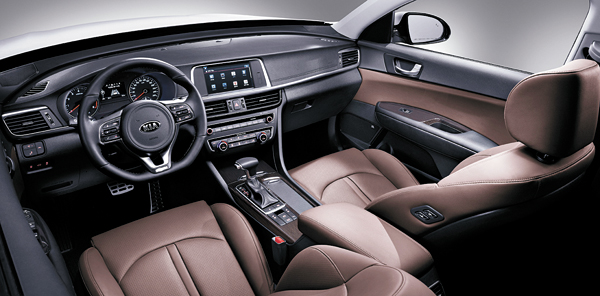New Hyundai Motor PR a two-way street

Interior of the new K5. Provided by the company
K5 hit the pole in accordance with crash test standards set by the U.S. National Highway Traffic Safety Administration.
The driver’s side of the car was crushed, but the dummy was not.
“I have heard that thinner and less sturdy steel sheeting was used for cars sold in the domestic market, and I wanted to see whether that was true,” said Lee Jae-geun, a 40-year-old who manages an auto blog. “After witnessing the crash test, I see the steel sheet is much sturdier than I had previously thought. The wheels and tires also maintained their shapes.”
Hyundai Motor Group on Thursday opened Kia Motors’ Hwaseong production plant and Hyundai Motor’s R&D center in Namyang, both in Gyeonggi, to five automobile bloggers and 35 members of auto internet cafes.
It was a highly unusual move for the automaker, which rarely makes its R&D center accessible to outsiders because of concerns that important corporate information might be leaked.
But these 40 people, opinion leaders in the online auto community, were invited to test and knock on the K5’s steel sheet and test its wireless cellphone charger.
They also got to have a discussion with Hyundai’s researchers over automatic emergency brakes. Automatic emergency brakes, known as AEB, allow the vehicle to stop automatically when a vehicle ahead stops suddenly or an obstacle appears.
“I even took a holiday from the company to see the interior of the new K5,” said 25-year old Kim Jung-won, who works in retail. “I really like the European-styled D-shaped wheel and leather interiors.”
The reason Kia Motors made an unprecedented invitation to the Internet community is because it has decided that the company’s “passive communication style of the 1990s” was no longer effective in changing the minds of the automaker’s many “anti-fans.”
“We felt that the rising popularity of imported cars was due to growing negative opinions about domestic brands,” said a Kia Motors official.
“One-way PR is no longer good enough to attract younger consumers in their 30s,” he said.
K5 is Kia Motors’ volume model, which sells more than 100,000 units per year. Kia aims to sell 400,000 cars globally per year.
Hyundai Motor also is working to earn some positive opinions. In February, it invited 30 members of Bobaedream, an online community well-known for its anti-Hyundai Motor stance.
In Paju, Gyeonggi, 30 of them got to test drive Hyundai’s new i40. In July last year, the automaker invited 20 opinion leaders of the auto sector’s Internet community for a crash test of the Genesis model to dispel rumors that the models for domestic and overseas markets were made differently.
“As segments of society became more diversified, we have reached a conclusion that communication through newspapers and televisions was inadequate,” said Byun Dong-moon, a sales executive at Kia Motors.
“Through face-to-face contact with professional bloggers and opinion leaders of the Internet community, we will make our issues more transparent and also work to resolve misunderstandings.”
BY KIM YOUNG-MIN [park.jungyoun@joongang.co.kr]










with the Korea JoongAng Daily
To write comments, please log in to one of the accounts.
Standards Board Policy (0/250자)